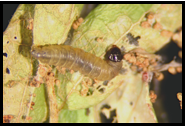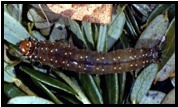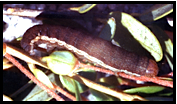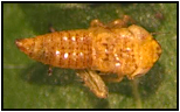- Blackheaded fireworm
- Spotted fireworm
- Sparganothis fruitworm
- Cranberry Blossomworm
- Blunt-nosed leafhopper
- New Insecticide Closer SC
The cranberry season has been off to a very slow start due to the cold weather. Insect activity is just starting to increase. Thus, growers need to intensify their scouting efforts. The following insect pests bear special mention for early-season scouting:
Remember: blackheaded fireworm is much easier to control if detected during the early part of the season.
Sparganothis fruitworm – This insect is a serious pest in most cranberry-growing states. Sparganothis fruitworm completes two generations a year and overwinters as an early-instar larva. Larvae from the 1st generation feed on foliage. In New Jersey, first generation adult moths emerge from mid-June through the first weeks in July; pheromone traps are commonly used to monitor adult flight and population size. Second-generation eggs are laid on cranberry leaves, and larvae will feed on fruit.
Cranberry Blossomworm – Adults lay their eggs in October in cranberry beds. The eggs overwinter and hatch over a period of several weeks. Early instars can be found during the first week of May. Larvae go through 6 instars to complete development. Because the first instars feed during the day (and also at night), scouting can be done during the daytime using sweep nets to estimate larval abundance. Larvae turn nocturnal during the later instars. At this time, night sweeping (9 pm – 1 am) is recommended for sampling. Larvae complete their development by June-July. Older instars are very voracious and capable of destroying 100 blossoms within a 3-week period. There is a pre-pupal that lasts until the end of August and a pupal stage that lasts until October. Adults emerge from end of August to end of October.
Lepidopteran Pests Monitoring and Control – Use sweep netting for monitoring early lepidopteran pests (pre-bloom). A sweep set consists of 25 sweeps and 1 sweep set is recommended per acre (this may vary depending the size of bogs). The action threshold for false armyworm, blossomworm, other cutworms, and gypsy moth (we use a combined threshold from adding all these caterpillars per sweep) is an average of 4.5 caterpillars in sets of 25 sweeps. For brown and green spanworms is an average of 18 per sweep set. The action threshold for blackheaded fireworm and Sparganothis fruitworm is an average of 1 to 2 per sweep set. We recommend the use of the reduced-risk materials Intrepid, Altacor, or Delegate if populations exceed action thresholds. These are reduced-risk, softer insecticides that are very effective against lepidopteran pests.
Leafhopper Monitoring and Control: Leafhopper nymphs can be sampled using sweep nets (as described above for lepidopteran pests). Nymphs before bloom are small; thus, you may need to freeze the samples (to kill them), and then count the number of nymphs under a microscope or using a magnifying lens. There is no threshold based on sweep net counts, so decisions should be made based by comparing current numbers with prior infestation history and/or incidence of false blossom disease in those beds.
In cases of high numbers of blunt-nosed leafhopper nymphs, we recommend application of a broad-spectrum insecticide, such as Diazinon or Lorsban. Broad-spectrum insecticides will disrupt biological control particularly the natural enemies (predators and parasitoids) of Sparganothis fruitworm, so their use should be restricted only to areas of high leafhopper populations.
A new insecticide Closer SC (Dow AgroSciences) has been registered for use in cranberries. This insecticide is very effective against sucking insects (aphids, leafhoppers, whiteflies, etc.); however, we do not have any data on its efficacy against blunt-nosed leafhoppers. We will be conducting some efficacy trials this year. This insecticide has both systemic and translaminar activity and is in a new class of insecticides called the sulfoximines.






